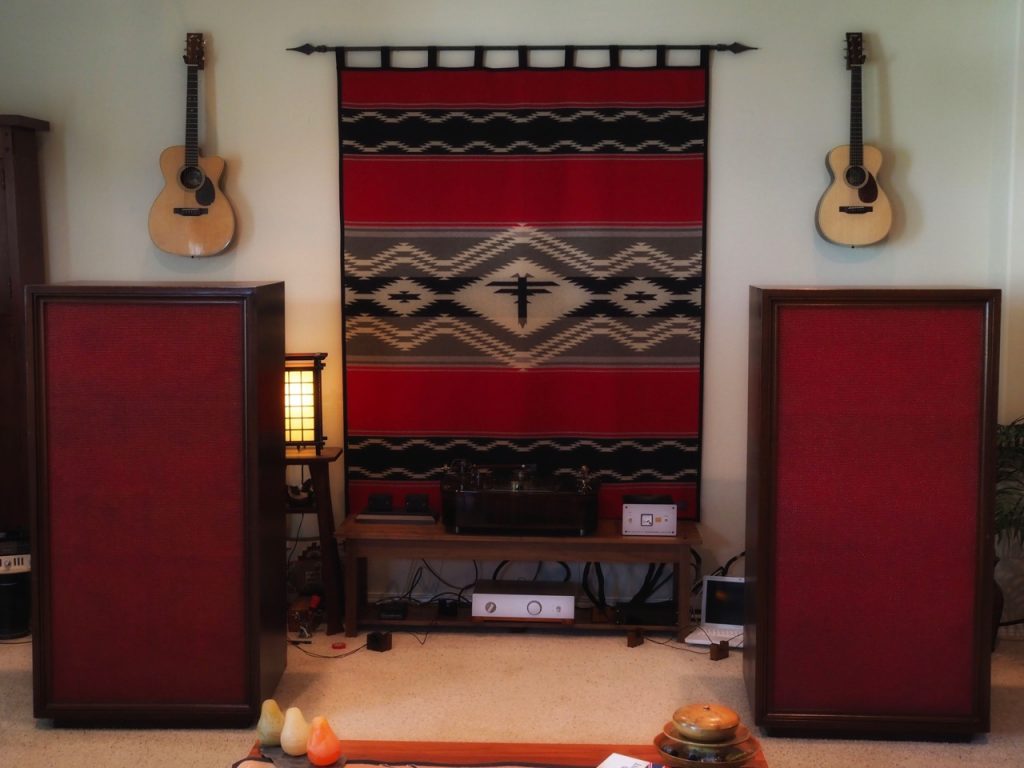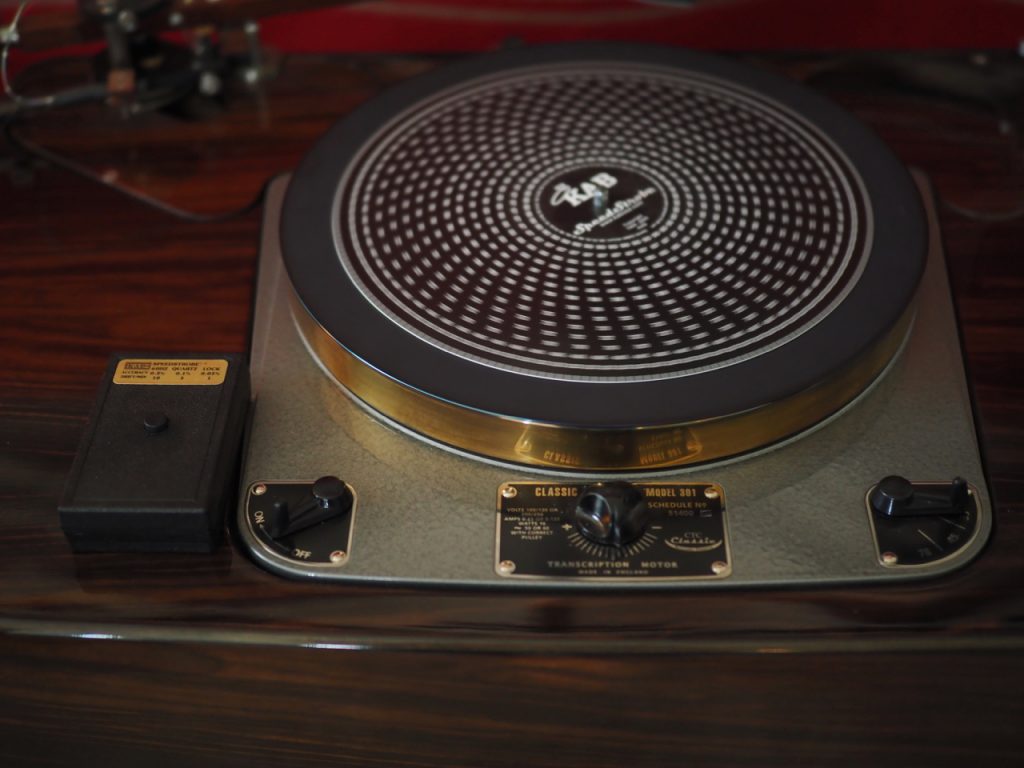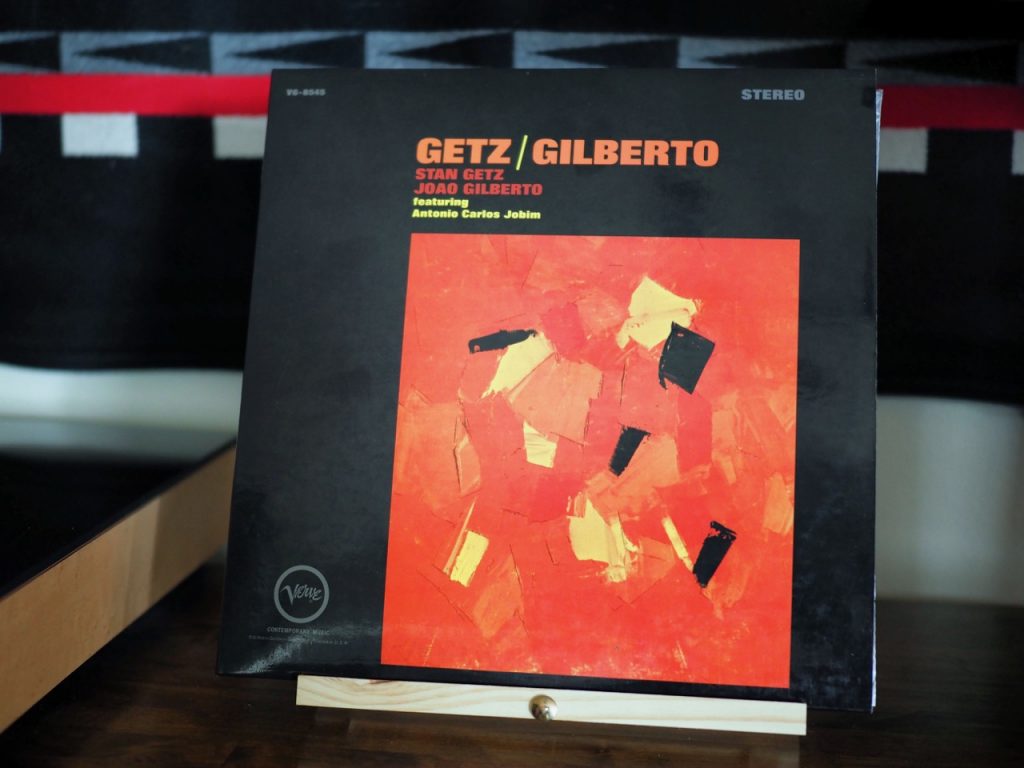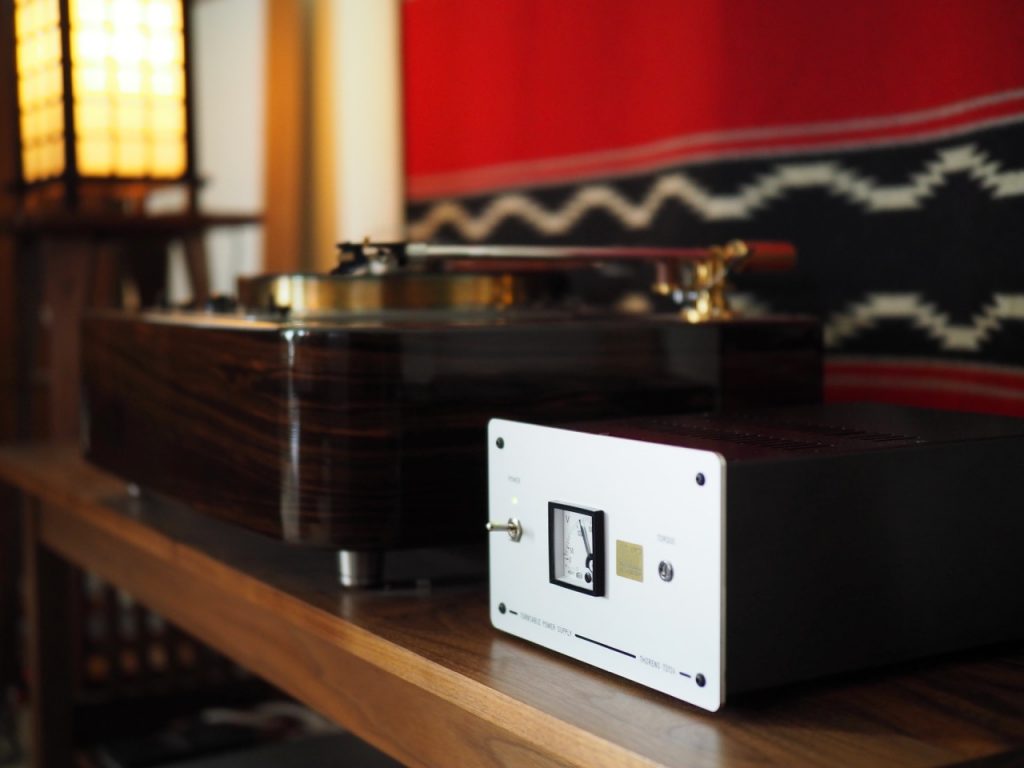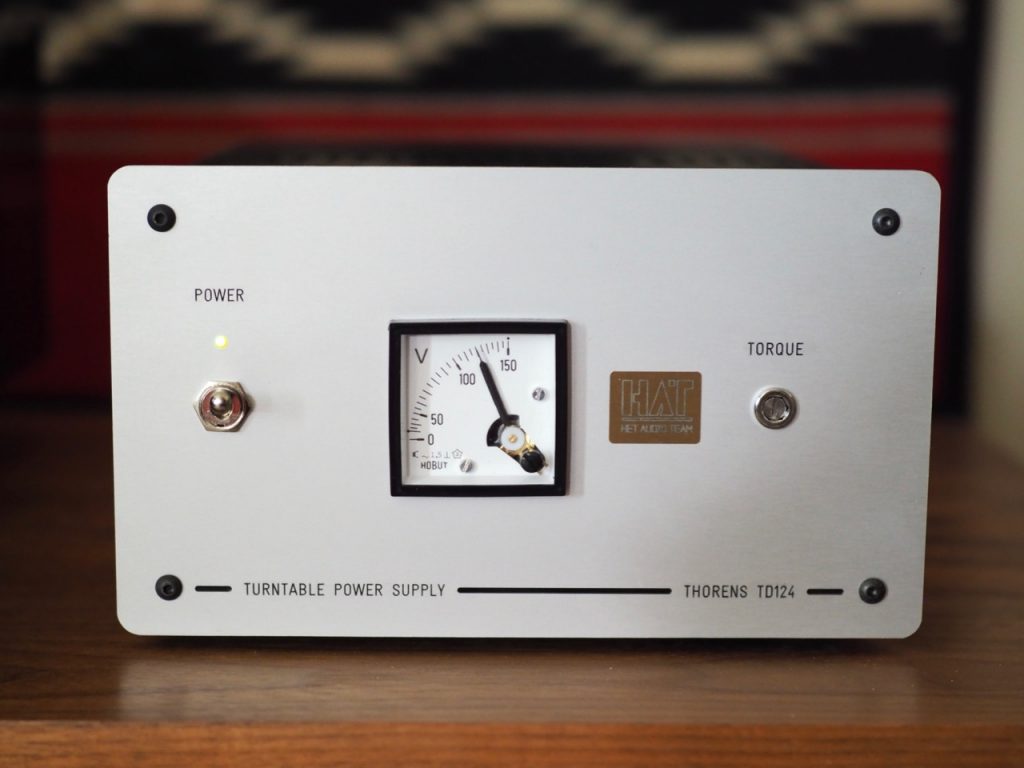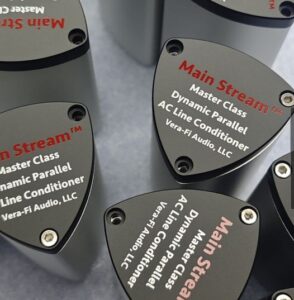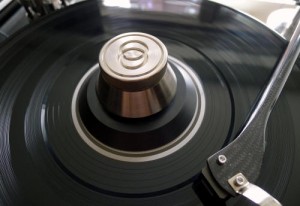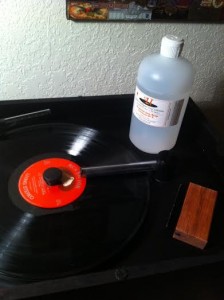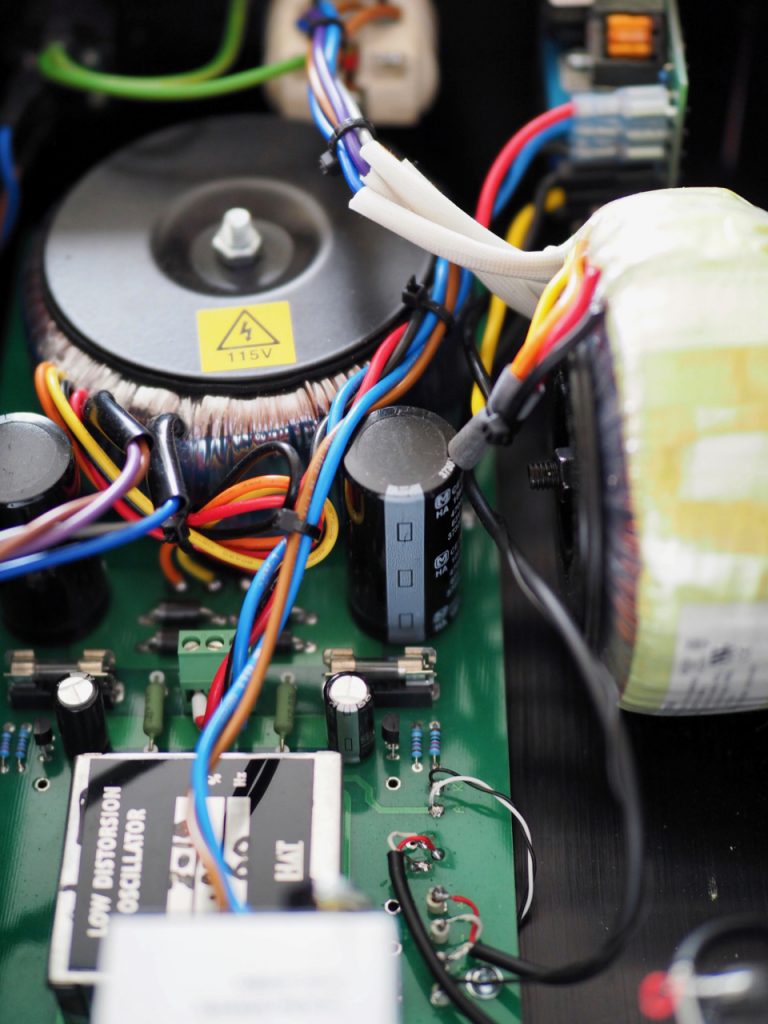
"All our turntable power supplies work with the same analog oscillator (above photo), variable or fixed to 50 or 60Hz, this delivers a pure sine wave with a distortion of 0.02%, and the output voltage is adjustable with the so-called torque regulator to optimally adjust it for every turntable motor."
"Most vintage record player motors have a power consumption maximum of 20 VA, so our power supply is designed to be able to deliver this continuously without getting hot."
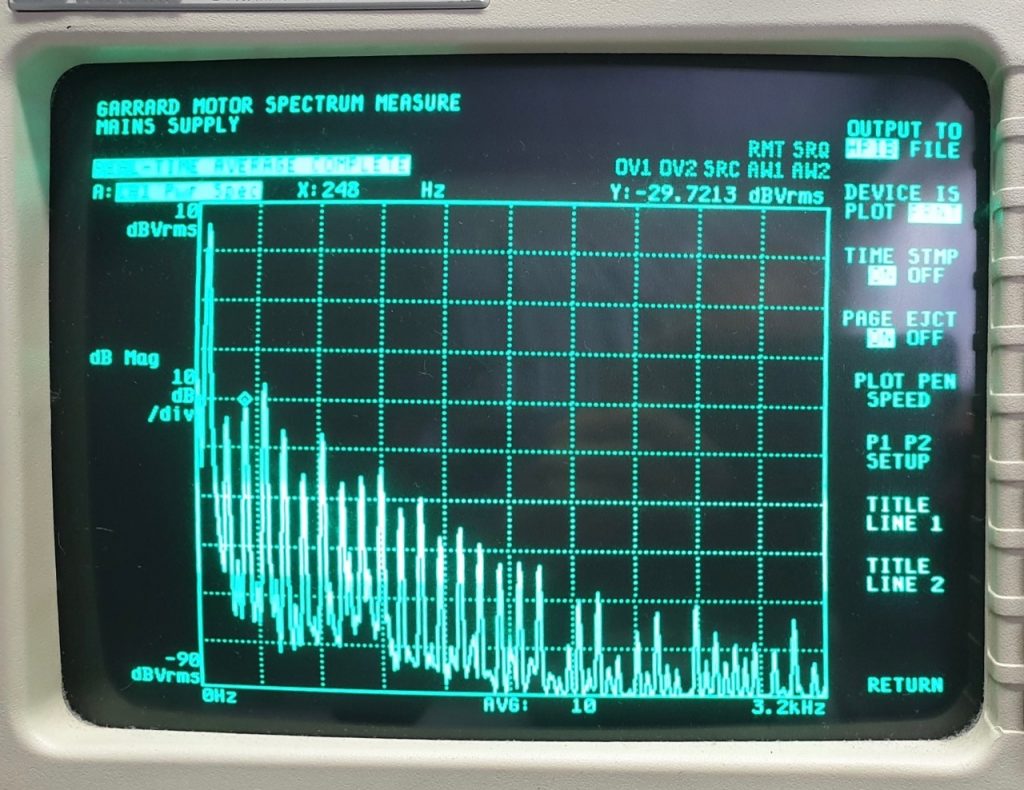
"The spectral current analyses show what is happening when the motor is connected to the mains supply (above). For a fair comparison, I have reduced the mains voltage to 200 volts by means of a Variac."
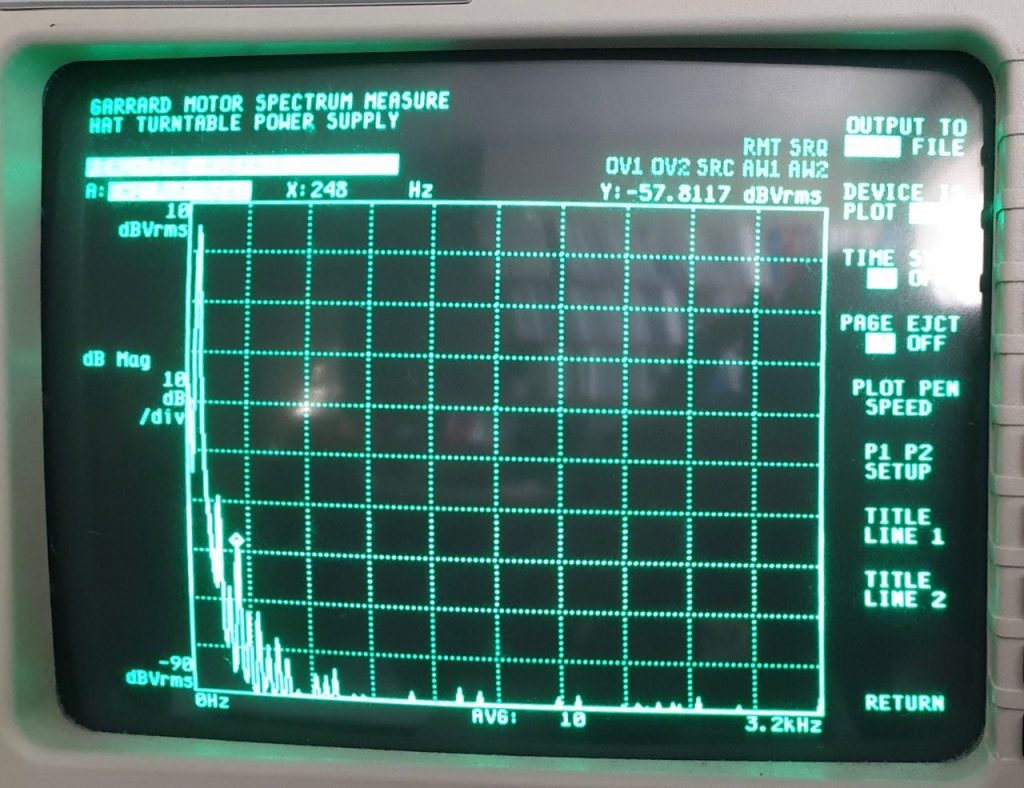
"The above spectrum is from the turntable connected to the HAT power supply at 200V, and you can see where the 5th harmonic goes from -37dB to -81dB!"
"Also, it can be seen that only lowering the mains supply to a lower voltage gave no better results, and harmonics stay, so passive filtering is no solution because 90% off the filters do not work at these low frequencies."
"Shaded pole motors are single-phase motors which must be controlled with a single-phase power supply. However, there are also record players that use single-phase motors because this is present, but can function much better with two phase or three phase motor control."
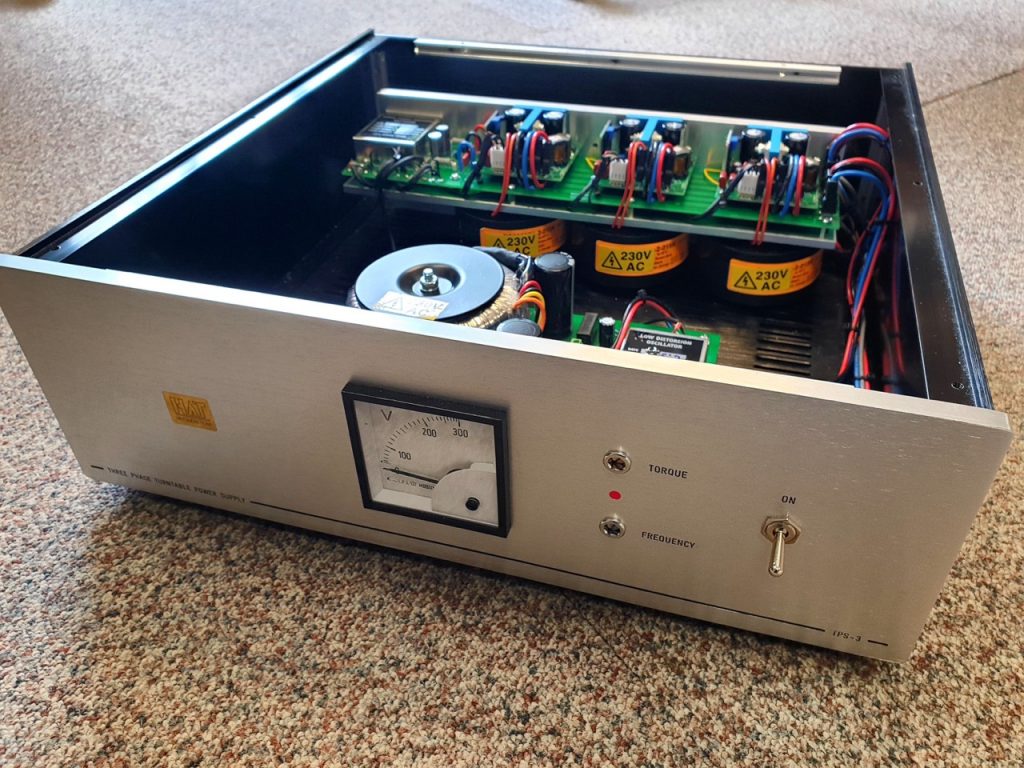
"Think of record players that use Bodine, Papst, Ashland, and EMT motors, and for these we have developed special power supplies that are built to order (photo above), and with these power supplies it is possible to make these motors very good with respect to vibration."

Jaap says, "The power supply is built without compromise with the best components available."
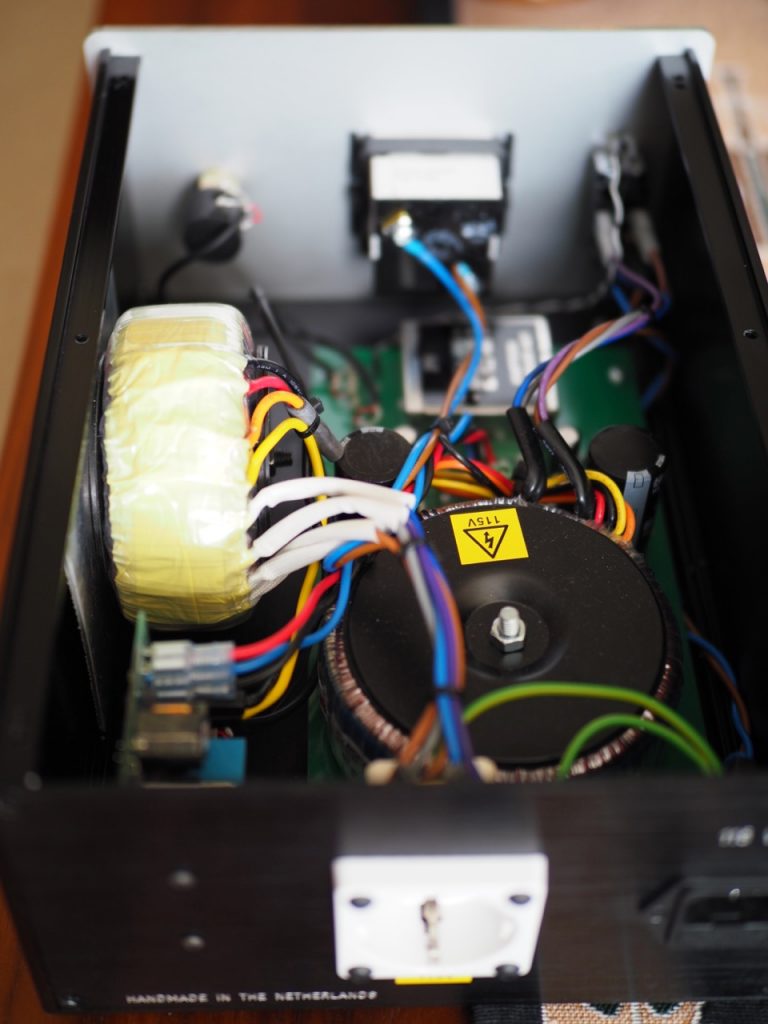
The Hanze HiFi HAT Turntable Power Supply's circuitry is designed to deliver low-noise voltage to drive the turntable motor, and provides the owner the ability to run the motor at lower voltage to reduce vibration.
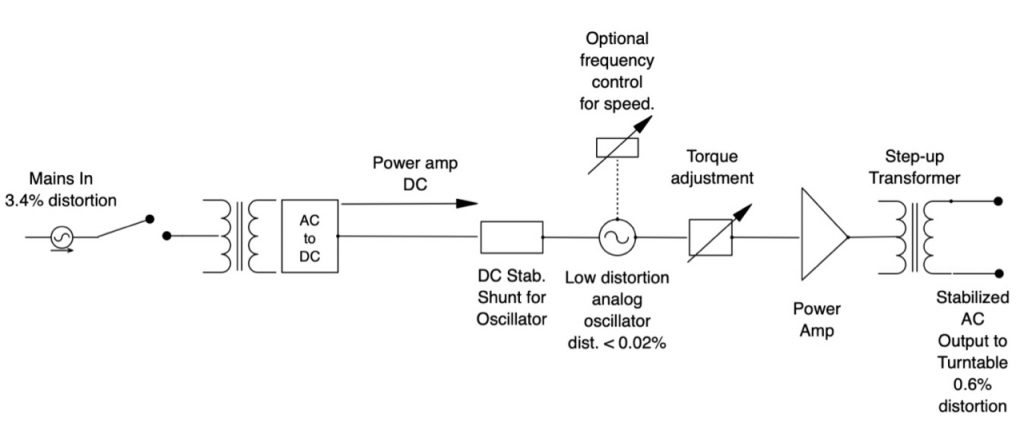
Diagram 1 - Note: the HAT TPS being reviewed does not have the optional frequency control for speed shown above.
Referring to the basic circuit diagram above for the HAT turntable power supply (above), I asked Hanze HiFi's Jaap Pees if he would explain what the HAT turntable power supply does with the wall AC that comes into it, to give you a better idea of how it works to improve the performance of a turntable.
"The mains comes in by a two-pole switch to the primary side from the mains step-down transformer, where the secondary side (voltage AC) is connected to the rectifier stage/capacitor, which delivers the DC voltage for the power amp and the stabilizing voltage stage for the analog oscillator."
"This voltage stabilizer stage is very important as it needs to have a very low noise level and a good stabilization factor because it feeds the 60Hz analog oscillator, and the output from this analog oscillator is independent from the variations of mains supply!"
"The output voltage from the analog oscillator goes to the torque adjustment, and here the user can vary the output voltage for optimum drive (for achieving the lowest vibration possible in the turntable motor – Jeff), and after that the low voltage from the analog oscillator is amplified from about 2 volts to 115 volts."
"This occurs in two stages, first with the power amplifier which drives the secondary side of the power output step-up transformer, and secondly where the primary side of the step-up transformer drives the turntable motor."
"As you can see the turntable motor is totally isolated from the mains supply and runs on a newly generated sine wave with low distortion and a stable voltage/frequency."
"For example, the mains voltage here in the Netherlands has a gross distortion of about 3-4 % THD, while the voltage coming from the HAT turntable power supply has a clean sine wave output with about 0.6% THD."
I don't know what the distortion is in the mains voltage where I'm located at in the USA, but my friend Ron Barbee is looking into the matter, so I might have more news soon.
I can tell you that in the USA and Canada national standards require that 60 Hz power be delivered at 120 volts ± 5% (114 volts to 126 volts), which means your mains voltage supply can vary in different locations, and also vary during the day due to different loads the grid experiences at different times of the day. The HAT turntable power supply's regenerated AC essentially removes any mains voltage variation as being an issue the turntable motor has to deal with.
So, to sum up Jaap's description of the HAT turntable power supply, it generates a new low-noise voltage source that is used to power the turntable's motor, and it also allows the owner to reduce the voltage used to drive the turntable motor via the torque adjustment, which reduces vibration in the motor. The resulting cleaner power to drive the motor, and the ability to reduce vibration in the turntable motor via the torque adjustment, works together to improve the fidelity of the turntable's performance.
You can see the HAT Turntable Power Supply on the Hanze HiFi website HERE. For the version of the HAT Turntable Power Supply with the torque control, the price is €1600, including 21% VAT, so for export outside the EU you would deduct the 21% VAT. By my calculation that means non-EU customers would pay €1185.
Review Systems
For this review I used two different systems, my main music listening system with my Classic Turntable Company / Artisan Fidelity Garrard 301 turntable, and my audio-visual system with my Artisan Fidelity Thorens TD-124 Statement turntable.
In both cases these turntables are some of the better examples of their kind, and are in better than new operating condition, with my Artisan Fidelity Thorens TD-124 Statement turntable having a newly restored motor (as well as everything else in it), and my Classic Turntable Company / Artisan Fidelity Garrard 301 turntable was serviced within the last 12 months, ensuring tip-top performance from both.
Main Music System Components
Since this review is about enhancing turntable performance, let's start with a detailed description of the turntable in my main music system, the Classic Turntable Company / Artisan Fidelity Garrard 301 turntable.
If you read my The Garrard Project 2015: From Simple to Spectacular! article in Issue 79, you know the project team of Ray Clark (Classic Turntable Company), Christopher Thornton (Artisan Fidelity), and myself, went to great lengths to get maximum performance from the Garrard 301 turntable platform.
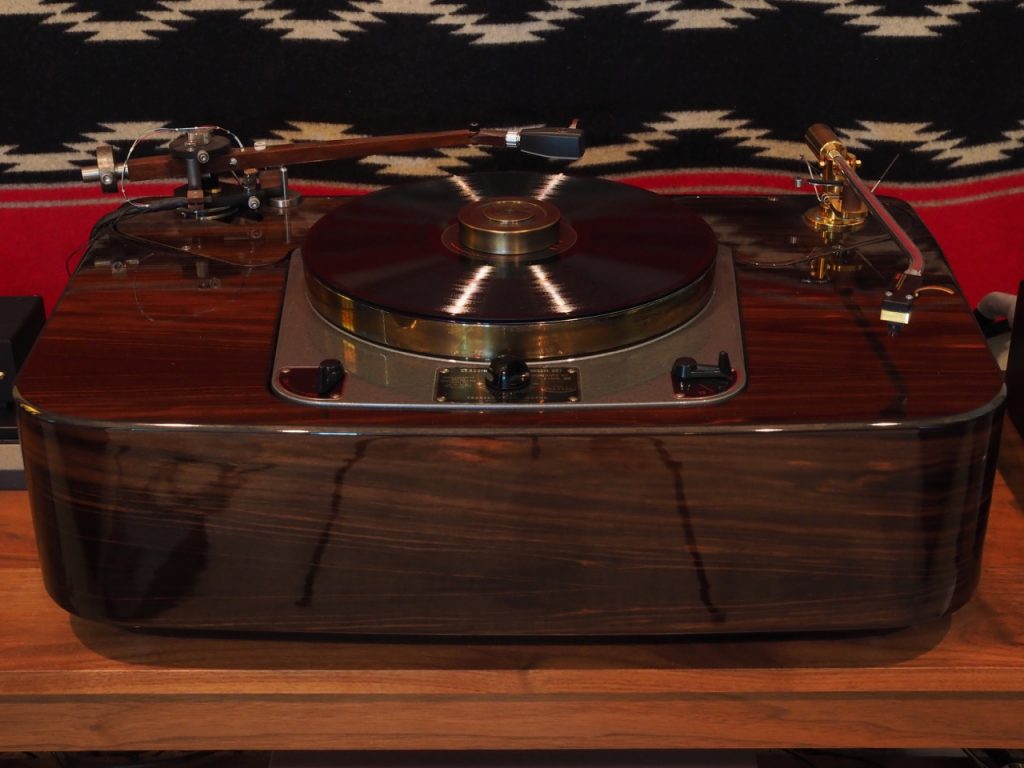
Ray Clark started with the basic Garrard 301 platform, but used a Garrard 401 motor instead of a 301 motor, as Garrard had replaced the aluminum motor housing of the 301 with a heavy cast iron housing in the 401 to help reduce vibration of the electric motor, and to provide magnetic screening, which improved the motor of the 401 to the point to where it was on par with most of the cutting lathes of the time in terms of rumble, wow, and flutter.
The flexy cast aluminum chassis of the original Garrard 301 was replaced with a rigid CNC'd aluminum chassis, and we used an oversized & perfectly balanced high-mass CNC'd brass platter, which spins on a precision spindle assembly uprated for the heavier platter.
The Artisan Fidelity "Statement" plinth is a constrained-layer damped high-mass design that was custom-fitted to Ray's Classic Turntable Company Garrard 301, and allows for the use of two tonearms.
Christopher said the materials and design of the plinth were, "carefully chosen based upon tested and proven predetermined criteria which involves ideal resonant characteristics, material density and individual tonal attributes."
Christopher will not divulge the exact details of his plinth design (proprietary), but will say that "hand selected kiln dried domestic hard woods combined with premium Russian Birch plywood and a blend of ultra-premium synthetic sealer resins were chosen ultimately for their liveliness and superior overall tonal attributes. The use of an integral motor drain cavity has been implemented for proper dissipation of any unwanted excess motor vibrations."
The custom Artisan Fidelity "Statement" plinth was fitted with Stillpoints isolation feet to reduce floor borne vibration.
To further reduce vibrational effects from the motor and floor-borne vibration, I've added Soundcoat Company GPDS damping material between the Classic Turntable Company Garrard 301's rigid CNC'd chassis and the Artisan Fidelity "Statement" plinth. The Soundcoat Company has been providing specialized noise control solutions for aerospace, medical, and industrial applications since 1963, and the strategic use of their various damping materials in audio components can make a big difference for reducing vibrational noise.
I use two tonearms on my Garrard 301 turntable, the first being a Thomas Schick 12-inch tonearm fitted with a Yamamoto HS-1A African black wood headshell, a Soundsmith Zephyr Mk III phonograph cartridge, and my DIY Art of Tone 22GA tinned-copper headshell leads.
Currently, the second tonearm is a 12.5-inch Pete Riggle Audio Engineering "Woody SPU" (review HERE) mounted with an Ortofon SPU Classic GM MkII stereo phono cartridge, stepped up with a bespoke Intact Audio SUT designed to get the best out of the Ortofon SPU Classic GM MkII.
For electronics, I used a Soundsmith MMP3 Mk II phono equalizer which I purchased following the review (HERE), and a SPEC RSA-M3 EX Real Sound Amplifier (review HERE).
For loudspeakers, I used custom Altec loudspeakers that were made for conductor and audio engineer Leopold Stokowski in the early 1960's, which are fitted with state-of-art custom Duelund CAST tinned-copper crossovers that are part of the Duelund-Altec Project (the feature article about the Duelund-Altec Project will be coming this summer to Positive Feedback).
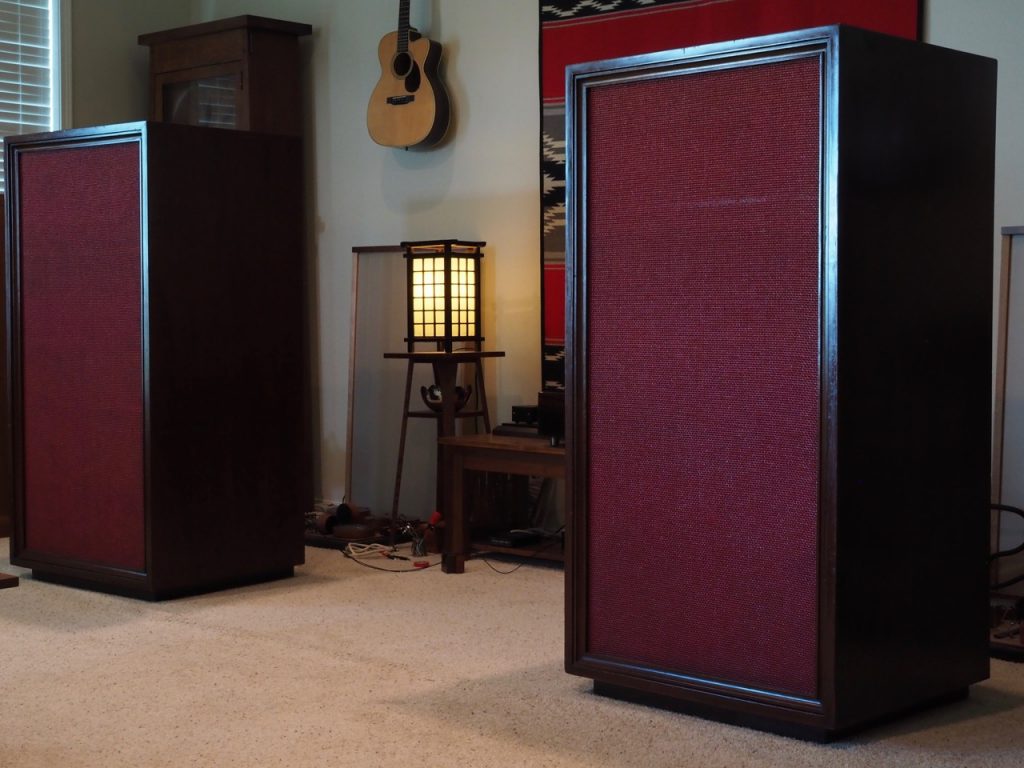
Duelund DCA20GA tinned-copper interconnects were used throughout, and Duelund DCA16GA tinned-copper wire was used as speaker cables (review HERE).
The mains AC power distribution starts at my AC wall outlet, consists of the Acoustic Revive CB-1DB receptacle base plate, the Acoustic Revive CFRP-1F carbon fiber outlet plate, and the Acoustic Revive modified Oyaide R-1 receptacle. The wall AC then leaves the outlet through an Acoustic Revive Absolute Power Cable (review HERE) and flows to an Acoustic Revive Absolute NCF Power Distributor (review HERE). From the Acoustic Revive Absolute NCF Power Distributor the AC is distributed to all of the components in my system via their AC power cords, which for this review was the Sablon Audio Petit Corona power cable that plugs into an Acoustic Revive RAS-14-TripleC NCF Power Stabilizer (review HERE), which is plugged into the turntable to power the motor.
Audio-Visual System Components
The audio part of my audio-visual system starts with my Artisan Fidelity Thorens TD-124 Statement turntable, which was restored and hot-rodded by Christopher Thornton of Artisan Fidelity, with all the deluxe sorts of things one expects from Christopher, like the "long base" plinth design that features a mass-loaded and constrained-layer damped Cocobolo and Panzerholz core, so I could accommodate my 12-inch Thomas Schick tonearm.
The custom Artisan Fidelity "Statement" plinth was fitted with Stillpoints isolation feet to reduce floor borne vibration.
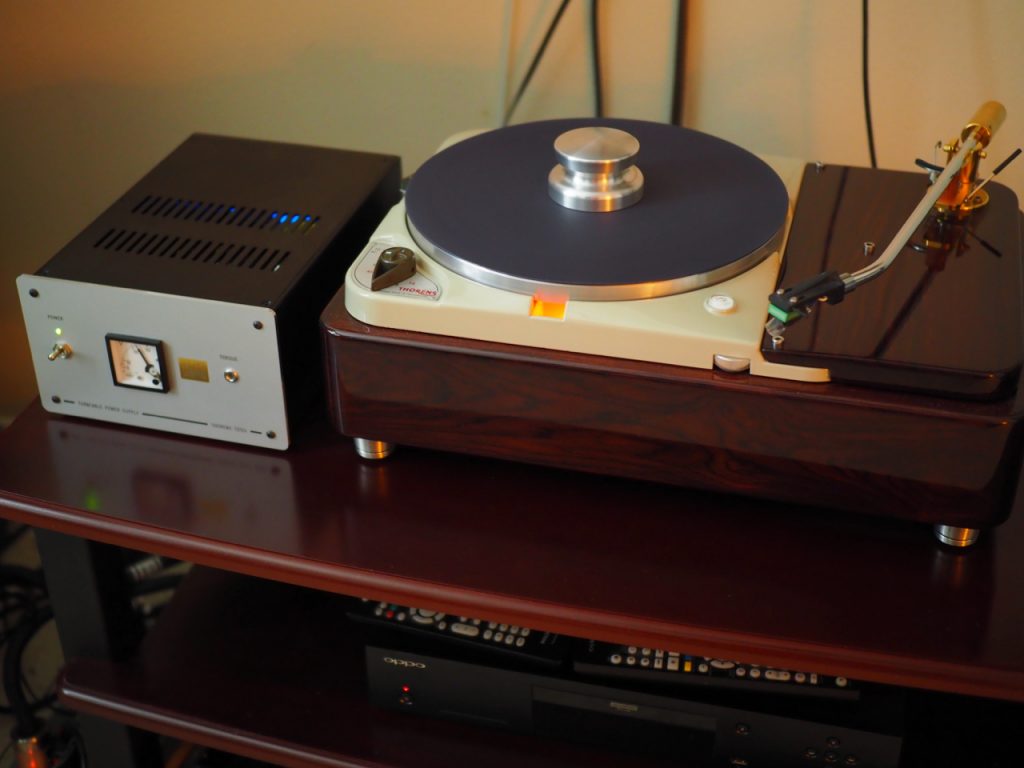
My Schick tonearm utilizes a Thomas Schick graphite headshell mounted with a Soundsmith Carmen MKII phonograph cartridge (review HERE), and is equipped with the exotic Acoustic Revive PC-TripleC/EX Headshell Leads (review HERE).
My Thorens TD-124 Statement is fitted "with a large bore stainless-steel self-lubricating precision main Sapphire bearing assembly featuring advanced synthetic co-polymer thrust pad," a CNC'd idler wheel with a stainless-steel hub, an austenitic stainless-steel precision balanced high mass main platter, and a Thorens factory restored TD124 aluminum clutch platter.
The TD-124 Statement has a new switch compressor condenser, a new Plexiglass strobe window, an E50 motor rebuild using new precision bushings, felt rings and seals, as well as a replacement stepped pulley wheel for the E50 motor.
Non-magnetic stainless-steel main chassis screws and armboard screws are used, and a Schurter IEC inlet with shielded oxygen free copper internal power cabling.
In my Artisan Fidelity Thorens TD-124 Statement turntable I also installed a Woodsong Audio Thorens TD-124 Platter Adapter ($75 USD), a SPEC AP-UD1 Analog Disc Sheet ($350 USD), an AudioSilente MKII suspension rods upgrade kit (€60 Euros, HERE), and a Hanze Hifi Thorens TD-124 Motor Decoupling Spring Kit (€39 Euros). You can read all about these Thorens TD-124 turntable upgrades in my Positive Feedback review HERE.
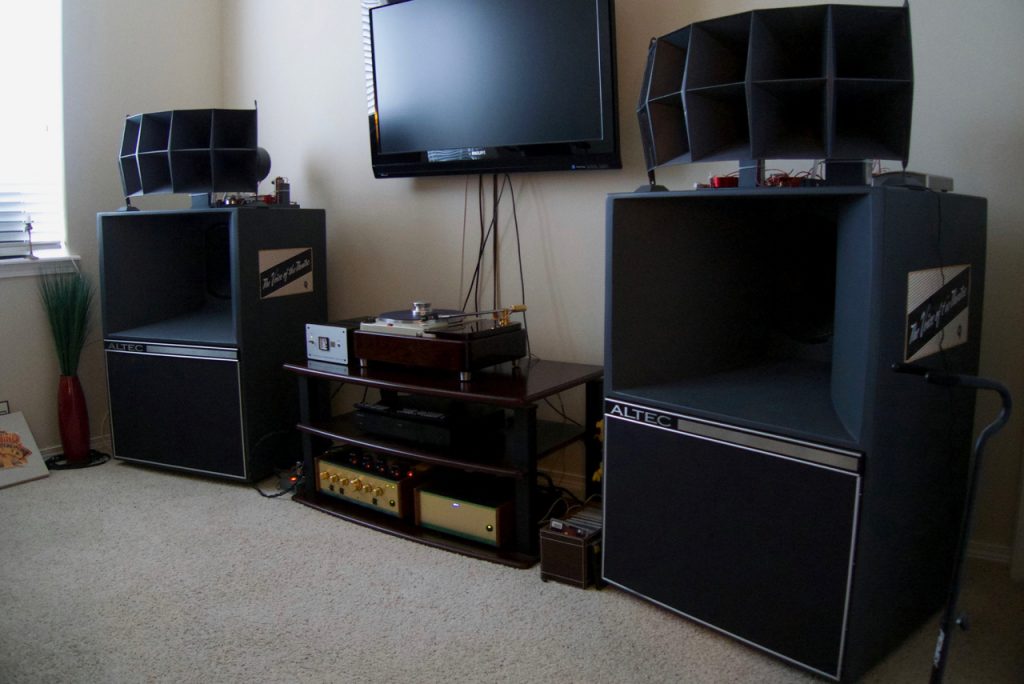
My vintage Altec A5 Voice of the Theatre loudspeakers were restored by Gary Fischer, which you can read more about HERE, HERE, and HERE.
The amplification electronics are long-time favorites of mine, the Leben CS-600 vacuum tube integrated amplifier and Leben RS-30EQ vacuum tube phono preamplifier, which makes for a great combination for providing thrilling music and film performances from the vintage Altec A5's.
I use Acoustic Revive RCA Absolute FM Interconnects for the Leben kit, an Acoustic Revive Absolute Power Cable for the CS-600, an Acoustic Revive Power Reference TripleC NCF AC Power Cable for the RS-30EQ, an Acoustic Revive RAS-14 AC Power Conditioner for the Thorens TD-124 (along with a Sablon Audio Petit Corona), and Duelund DCA16GA tinned-copper speaker cables to connect the Leben CS-600 to the Altec A5 loudspeakers. Everything is plugged into a Belkin ten outlet power strip, which in turn plugs into a generic AC outlet to connect to wall AC.
Listening Impressions
When I unpacked the Hanze HiFi HAT turntable power supply from its shipping box, I noticed there was no user guide included. It turns out that Hanze HiFi has not yet written a user guide for the HAT turntable power supply, as most are purchased by customers after in-store auditions, and are then setup for the owners by Hanze HiFi.
So, for purchasers from other locations, I suppose you could consider this article to be a user guide of sorts, as it describes my experiences learning about, using, and optimizing the voltage output of the Hanze HiFi HAT turntable power supply for two different turntables in two different review systems.
In the USA and Canada, national standards require that 60Hz power be delivered at 120 volts ± 5% (114 volts to 126 volts), so out of curiosity I measured the mains voltage at my outlets over a few days to get an idea of how the mains voltage varies over time. Where I live, the voltage appears to be fairly stable over time, with daily variation being in the range of 119.2V to 120.5V ± a few tenths to a half of a volt for any given measurement.
As an initial reference, I adjusted the output voltage of the Hanze Hifi HAT turntable power supply to 120V, and then I listened for audible differences in performance from that provided by the mains.
The idea was that by setting the HAT turntable supply to 120V, to be about the same voltage as the mains voltage, it would tell me how much of the performance enhancement was due to the regenerated AC supply for the turntable motor, and how much was due to reducing the turntables' motors' vibration by running the motors at lower voltages, which I did in the second step, as described below.
In the second step, I wanted to hear how different voltages affected the motor vibration, and how that related to overall sound quality. Initially I tried numerous voltage settings with both turntables without getting the results I'd hoped for, so I asked Jaap for advice. Jaap recommended a 10% voltage reduction to the motors as a starting point (i.e. 12V here in the USA), and then I varied the output voltage of the HAT turntable power supply until I found the voltage reduction that provided the greatest musical & sonic improvement for the motor in each turntable, and then recorded my listening impressions at that setting.
Let me mention now that the power cables used to connect the mains AC to the HAT turntable power supply, and the power supply to the turntable, make as much of a difference in performance (i.e. big) as do power cables when used with a power amplifier or preamplifier, for example. You certainly can get decent results using a generic power cable, but I found I could get even better results using high-performance power cables.
So, for this review I used Sablon Audio Petit Corona power cables to connect the Hanze HiFi HAT turntable power supply to the mains AC and to the turntables. The improvement in performance from using the Sablon Audio Petit Corona power cables over generic power cables with the Hanze HiFi HAT turntable power supply was substantial.
Classic Turntable Company / Artisan Fidelity Garrard 301 Turntable
First up for listening comparisons was my Garrard turntable in my living room music system, with the Stokowski Altec's, the Spec RSA-M3 EX Real Sound Amplifier, and the Soundsmith MMP3 Mk II phono stage, etc., as described earlier.
Before each listening session I adjusted the speed of my CTC Garrard 301 with a KAB Speed Strobe so that speed was spot-on for the 33 1/3 RPM and 45 RPM LPs I was using as references.
I listened to selections of music with the Garrard powered by the mains supply, then I listened again to the same selections of music with the Hanze HiFi turntable power supply providing the AC.
To determine a baseline reduced voltage setting for the Hanze HiFi HAT turntable power supply, I used the superb Analogue Productions 45 RPM version of Getz/Gilberto.
Even before inserting the Hanze HiFi HAT turntable power supply into the system, "The Girl From Ipanema" sounded absolutely ravishing both musically & sonically through the Stokowski Altec's fitted with Duelund-Altec Project's Duelund CAST tinned-copper crossovers, providing a relaxed clarity, a big sense of the recording's acoustic space, vivid images, superb overall musicality, and with the gorgeous live-like vocals of Astrud and João Gilberto.
After inserting the Hanze HiFi HAT turntable power supply into the system, and setting it to provide a clean 120V of regenerated AC to power the Garrard, "The Girl From Ipanema" had slightly more vivid imaging, with a little more transparency, resolution, and spaciousness, but I had to listen closely to hear it, as the effects were relatively subtle compared to powering my Garrard directly from the mains AC.
Musicality elements like timbre and tone color in "The Girl From Ipanema" seemed about the same, although rhythm, melody, and dynamics were portrayed with slightly more intensity.
Concerning loudness, I kept the volume exactly the same for all listening comparisons, which I thought was approximately representative of live music, observing dB's ranging from the high 70's, with the highest dynamic peak hitting a bit above 98dB. For the same volume setting, the music sounded a little bit louder with the Hanze HAT turntable power supply, probably because the dynamic swings were portrayed with slightly more intensity.
Comparing the Garrard powered by the Hanze HiFi HAT turntable power supply at 120V to the mains supply at 120V, the improvements to overall musicality and sonics were subtle but beneficial.
I suspect that the amount of improvement one hears from the Hanze HiFi HAT turntable power supply in their locale, when using the same voltage as the mains supply, is directly proportional to how much noise is present in the mains AC where one lives.
The noisier your mains AC is, the more improvement you should realize using the Hanze HiFi HAT turntable power supply. The mains AC supply is pretty good where I live, so the differences were on the subtler side.
Next, I wanted to explore the second aspect of performance offered by the Hanze HiFi HAT turntable power supply, dropping the voltage going to the Garrard's motor to reduce motor vibration.
To start I set the voltage to approximately 108V with the torque adjustment per Jaap's recommendation, and after adjusting the speed of the Garrard to 45 RPM with the KAB Speed Strobe, I gave "The Girl From Ipanema" another listen.




